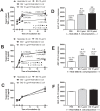Oral administration of live- or heat-killed Candida albicans worsened cecal ligation and puncture sepsis in a murine model possibly due to an increased serum (1→3)-β-D-glucan
- PMID: 28750040
- PMCID: PMC5531434
- DOI: 10.1371/journal.pone.0181439
Oral administration of live- or heat-killed Candida albicans worsened cecal ligation and puncture sepsis in a murine model possibly due to an increased serum (1→3)-β-D-glucan
Abstract
Candida albicans is the most common fungus in the human intestinal microbiota but not in mice. To make a murine sepsis model more closely resemble human sepsis and to explore the role of intestinal C. albicans, in the absence of candidemia, in bacterial sepsis, live- or heat-killed C. albicans was orally administered to mice at 3h prior to cecal ligation and puncture (CLP). A higher mortality rate of CLP was demonstrated with Candida-administration (live- or heat-killed) prior to CLP. Fecal Candida presented only in experiments with live-Candida administration. Despite the absence of candidemia, serum (1→3)-β-D-glucan (BG) was higher in CLP with Candida-administration than CLP-controls (normal saline administration) at 6h and/or 18h post-CLP. Interestingly, fluconazole attenuated the fecal Candida burden and improved survival in mice with live-Candida administration, but not CLP-control. Microbiota analysis revealed increased Bacteroides spp. and reduced Lactobacillus spp. in feces after Candida administration. Additionally, synergy in the elicitation of cytokine production from bone marrow-derived macrophages, in vitro, was demonstrated by co-exposure to heat-killed E. coli and BG. In conclusion, intestinal abundance of fungi and/or fungal-molecules was associated with increased bacterial sepsis-severity, perhaps through enhanced cytokine elicitation induced by synergistic responses to molecules from gut-derived bacteria and fungi. Conversely, reducing intestinal fungal burdens decreased serum BG and attenuated sepsis in our model.
Conflict of interest statement
Figures





References
-
- Singer M, Deutschman CS, Seymour CW, Shankar-Hari M, Annane D, Bauer M, et al. The Third International Consensus Definitions for Sepsis and Septic Shock (Sepsis-3). JAMA. 2016;315(8):801–10. doi: 10.1001/jama.2016.0287 ; - DOI - PMC - PubMed
-
- Hotchkiss RS, Monneret G, Payen D. Sepsis-induced immunosuppression: from cellular dysfunctions to immunotherapy. Nat Rev Immunol. 2013;13(12):862–74. doi: 10.1038/nri3552 ; - DOI - PMC - PubMed
-
- Srisawat N, Kellum JA. Acute kidney injury: definition, epidemiology, and outcome. Curr Opin Crit Care. 2011;17(6):548–55. doi: 10.1097/MCC.0b013e32834cd349 . - DOI - PubMed
-
- Mayr FB, Yende S, Angus DC. Epidemiology of severe sepsis. Virulence. 2014;5(1):4–11. doi: 10.4161/viru.27372 ; - DOI - PMC - PubMed
MeSH terms
Substances
LinkOut - more resources
Full Text Sources
Other Literature Sources
Medical
Molecular Biology Databases
Miscellaneous

